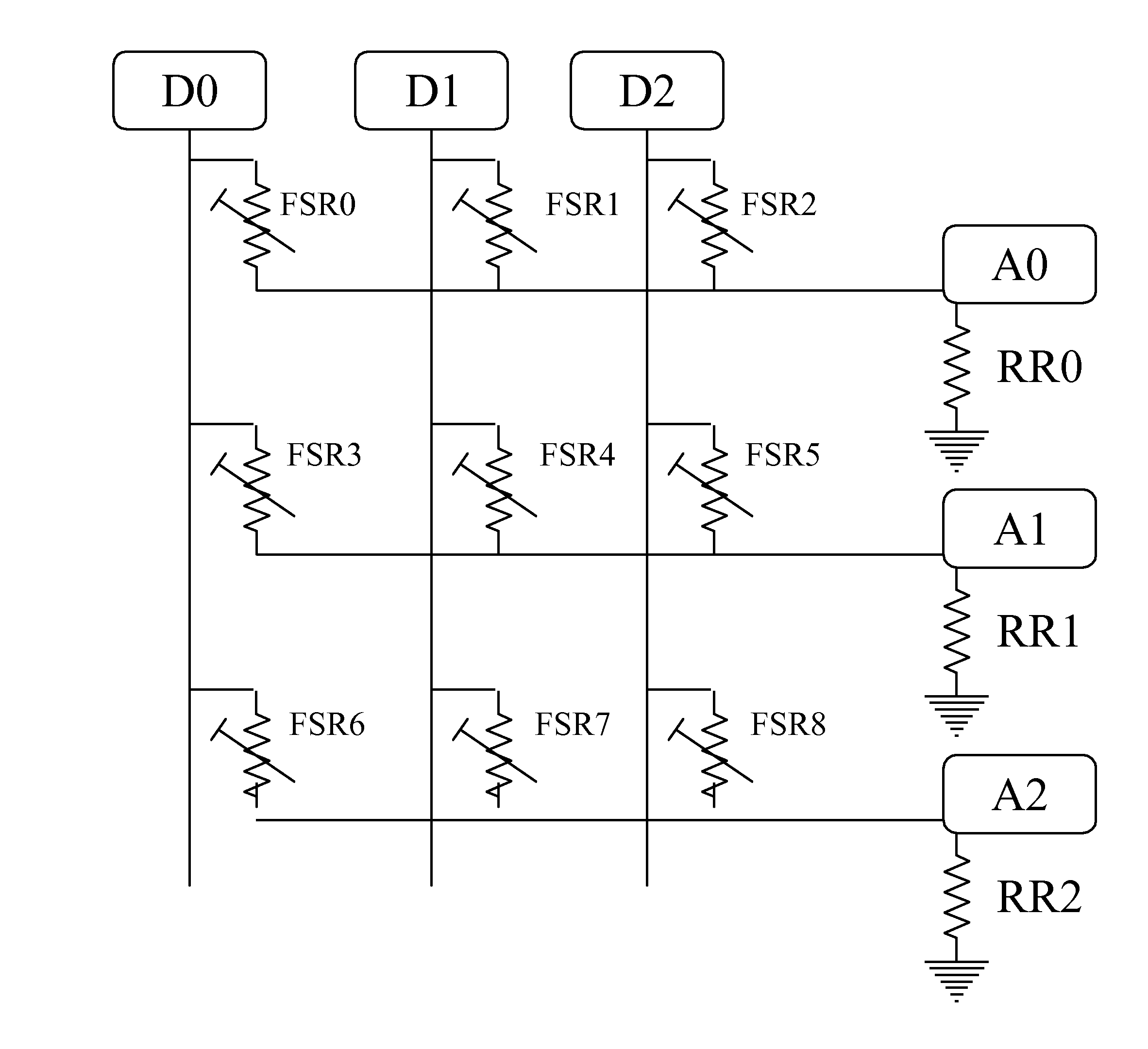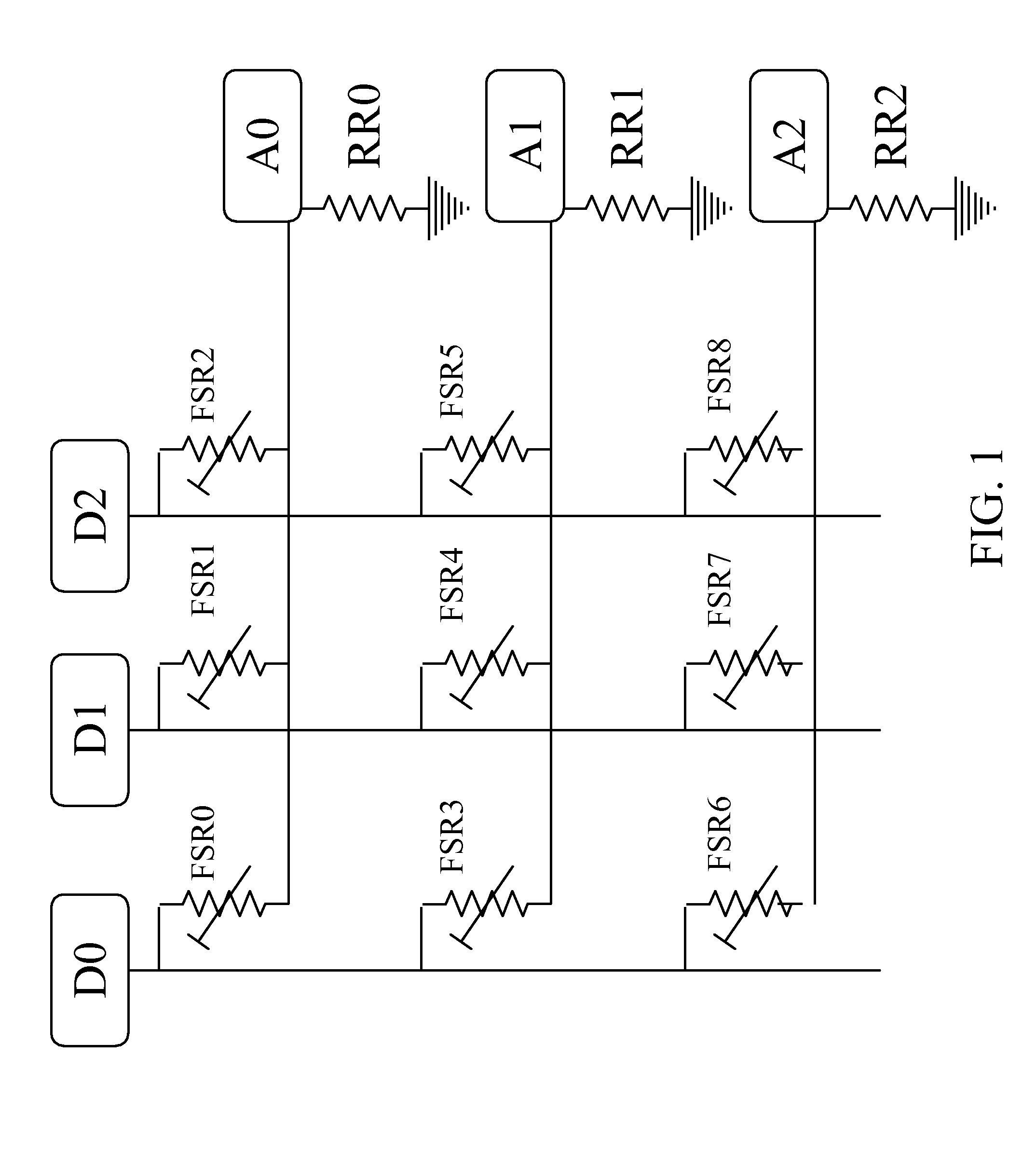Resistive Force Sensing Circuit
a sensing circuit and resistive force technology, applied in the field of resistive force sensing circuits, can solve the problems of consuming more power, affecting the output value, and affecting the accuracy of data, so as to reduce interference, reduce leakage current, and simplify circuit structure and scanning method
- Summary
- Abstract
- Description
- Claims
- Application Information
AI Technical Summary
Benefits of technology
Problems solved by technology
Method used
Image
Examples
second embodiment
[0046]The similar scanning process as the conventional resistive force sensing circuit of FIG. 1 can be used on the resistive force sensing circuit of the present invention, but a simple algorithm is required to be performed to separate the output value resulted from different force-sensing resistors FSR0 to FSR8. One of examples of such algorithms will be described in reference with drawings hereafter. In that case, the sensor circuit outputs which are not driven by the output driving circuit are grounded. Since the first and second resistors R01 to R81 and R02 to R82 exist, the grounded resistors in the conventional resistive force sensing circuit are not required.
[0047]FIGS. 5A and 5B are schematic circuit diagrams of equivalent circuits of the resistive force sensing circuit of FIG. 4 for two different scanning configurations. With reference to FIGS. 5A and 5B, the scanning method used in this embodiment will be described in detail. In following description, the scanning step wh...
first embodiment
[0053]It is worth to mention that the configuration of the sensor circuit inputs and the gaps of two adjacent sensor circuit outputs is not necessary a matrix. With reference to FIG. 7 for a schematic circuit diagram of a resistive force sensing circuit for sensing forces at multiple points according to the forth embodiment of the present invention. In FIG. 7, the sensor circuit inputs D0, D1 and D2 are configured as concentric rings, and the sensor circuit outputs A0, A1 and A2 are configured as radial lines. The electrical connection between the sensor circuit inputs D0, D1 and D2, the sensor circuit outputs A0, A1 and A2, the force-sensing resistors FSR0 to FSR8, and the first and second side resistors R01 to R81 and R02 to R82 are similar to the circuit in FIG. 3. The force-sensing resistor, the first and second side resistors can still form a resistor unit by connecting each other at one point, for example, the force-sensing resistor FSR3, and the first and second side resistor...
sixth embodiment
[0070]FIG. 11 is a schematic top view of a resistive force sensing apparatus with multiple point force sensing function according to the present invention, and FIG. 12 is a schematic view of one resistor unit and electrodes connected to the resistor unit structure of the resistive force sensing apparatus in a circle of a dotted line of FIG. 11.
[0071]In this embodiment, it can be seen that not only the structure of the fifth embodiment but also other structures can realize the resistive mentioned above, such as the structure of the resistive force sensing apparatus of the sixth embodiment of the present invention. As showed in FIG. 11, the resistive structure included in the resistive force sensing apparatus can be seen as a 4*4 matrix, and the method to define the matrix is similar to the fifth embodiment of the present invention in FIG. 9. It is worth to mention that the resistor structures 00 to 80 of the sixth embodiment in FIG. 11 are substantially separated from each other, in ...
PUM
 Login to View More
Login to View More Abstract
Description
Claims
Application Information
 Login to View More
Login to View More - R&D
- Intellectual Property
- Life Sciences
- Materials
- Tech Scout
- Unparalleled Data Quality
- Higher Quality Content
- 60% Fewer Hallucinations
Browse by: Latest US Patents, China's latest patents, Technical Efficacy Thesaurus, Application Domain, Technology Topic, Popular Technical Reports.
© 2025 PatSnap. All rights reserved.Legal|Privacy policy|Modern Slavery Act Transparency Statement|Sitemap|About US| Contact US: help@patsnap.com



